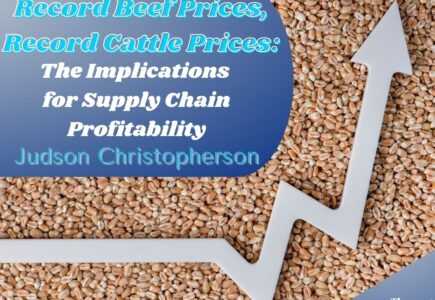The implications for supply chain profitability
Judson Christopherson
Throughout the Covid-19 pandemic, beef prices on store shelves across North America reached record highs. As the world has recovered from the pandemic, beef prices have remained elevated as food security, inflation, and economic wellbeing become increasingly pertinent issues in Canada and the United States. Why have cattle prices remained high, and who is reaping the rewards? Where will the market go from here, and how will this impact the supply chain long-term? These important questions will be explored throughout this blog, highlighting some fundamental imbalances in the supply chain that stand to hurt beef producers and consumers alike.
Inflation or Greed?
The proportion of consumers who feel retailers are taking more than their fair share of supply chain profits by using inflation as an excuse, an act commonly called ‘greedflation’, grew to 68% last year. However, there may be little merit behind such claims until recently, especially regarding beef production. In 2022, the retail share of each dollar of the shelf price for beef products fell to a mere 2 cents. The division of the remaining 98 cents throughout the supply chain was far from even as packers received 59 cents, and farm gate cattle producers received only 39 cents of the retail dollar.
For a 39% stake, cattle producers must retain an animal for 18-20 months, incurring significant feed, veterinary, labour, land, interest, machinery, and opportunity costs during this time. Adding to this, high levels of market, weather, and biological risk are taken on by the livestock producer. In comparison, while a beef abattoir does have high overhead and operating costs, the product is converted from a live animal to a shelf ready product in mere days. Similarly, a retailer must turnover beef products in days to avoid wasting highly perishable beef products.
More recent research has found the retail share of each dollar of beef has skyrocketed to 48%, with packers earning a mere 13%, and cattle production receiving the balance. This displays a minimal change in the cattle production share but also the highly dynamic margins present in the beef supply chain downstream from the farmgate. Nonetheless, cattle producers have seen a long-term contraction of their value share from near 65% in 1970, to approximately 40% today.
Realignment Moving Forward?
Throughout 2023 the market for live cattle of all classifications, ages, and weights has experienced an upward progression to record-breaking levels. However, the current macroeconomic conditions where input costs inflate at a rate greater than livestock prices raise concerns that even record-breaking prices will not translate to profitability in the cattle sector. Other pundits however are citing a potential shift in the agricultural sector, with long-term projected returns to cow-calf production exceeding grain and oilseed production for the first time in decades. Optimism appears to be high in the cattle sector and should remain so as long as livestock supplies remain tight. If high grocery store prices suppress consumer demand as the principles of microeconomics tell us they should, a realignment in the beef supply chain may be in order. Exactly how the share of each dollar of beef will be divided is largely undecided although it appears the cattle producer may be in store for a period of retribution, clawing back their share of the beef dollar.

